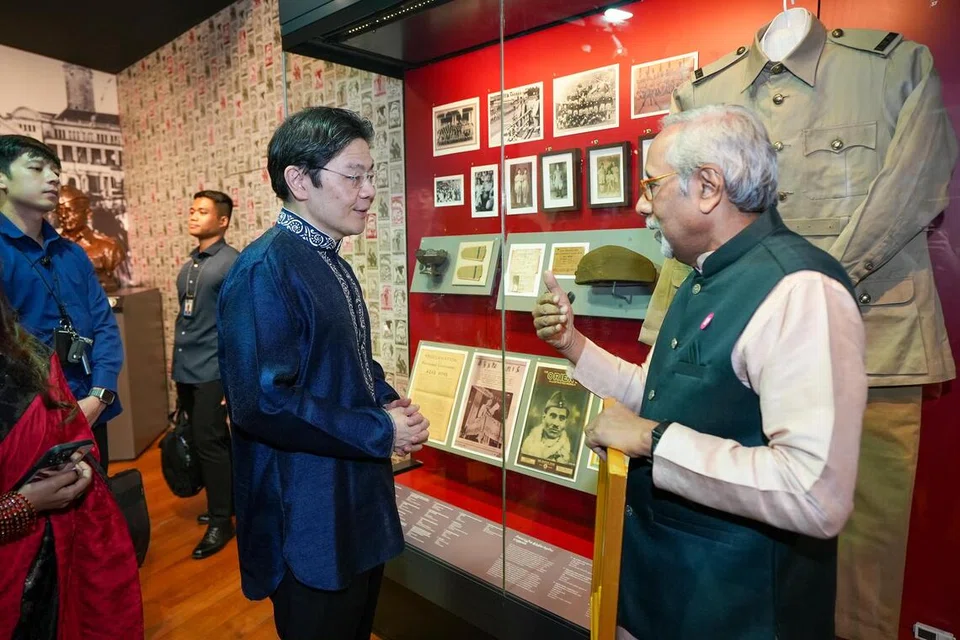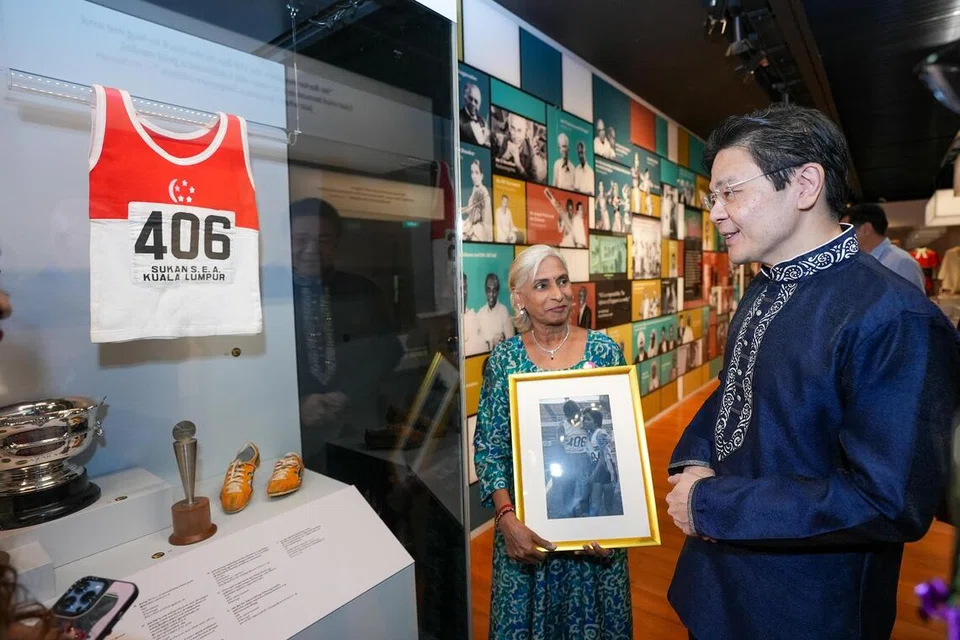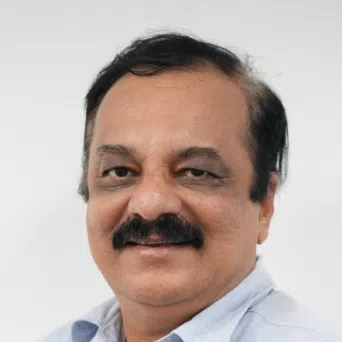The Indian Heritage Centre (IHC) marked a major milestone on Nov 14 as it celebrated its 10th anniversary with a dinner attended by Prime Minister Lawrence Wong, paying tribute to the community partners, donors and visitors who have shaped its journey over the past decade.
For Mr Wong, the evening at the centre in Little India was also a return to familiar ground. He had officiated at the opening of the IHC in May 2015 in his then role as Minister for Culture, Community and Youth, when the institution first began its mission to showcase Indian and South Asian history, heritage and culture in Singapore.
A tapestry woven from many threads
In his address, Mr Wong situated the centre’s story within the broader history of the Indian community in Singapore.
Since the earliest days of modern Singapore, he noted, people from the Indian sub-continent had arrived from regions such as Tamil Nadu, Kerala, Bengal, Punjab, Gujarat and Maharashtra, bringing with them their skills, beliefs and hopes for a better life. They spoke different languages, practised different faiths, and contributed a rich diversity of customs, cuisines, arts and festivals.
“They enriched our society with a vibrant array of customs, cuisines, arts and festivals… from Deepavali and Pongal to Thaipusam,” said Mr Wong, adding that Indian influences are now deeply woven into the Republic, from the food Singaporeans enjoy to the words they use in daily speech.
Like the Indian community, he said, Singapore itself is “a tapestry woven from many threads – multiracial, multi-religious and multicultural”.
“Our diversity need not and must not divide us. Instead, when we respect one another, when we celebrate one another’s culture, our diversity becomes a tremendous source of strength and unity,” he stressed.
Mr Wong also paid tribute to the generations of Indian immigrants and their descendants who have helped the Singapore Indian community flourish, keeping alive their heritage while embracing a shared national identity.
“So you are not just Indians in Singapore; you are Singaporean Indians,” he said. “We are Singaporeans first. We are rooted in our respective cultures, respective roots, yet deeply woven into the fabric of our nation. And you, all of you, our Indian community, are a proud and vital part of our Singapore story.”

A decade as a “living” heritage hub
Opened in 2015 as part of Singapore’s SG50 celebrations, the IHC has, in just 10 years, grown from a new heritage institution into a vibrant community space for Indians, other Singaporeans and foreign visitors.
The centre has welcomed almost 1.8 million visitors through its doors, and has become a regular stop on the cultural calendar with its large-scale celebrations of festivals such as Pongal, Indian New Year and Deepavali.
It also runs museum-based Learning programmes through which Primary 5 students visit IHC as part of the national school curriculum, giving younger Singaporeans a first-hand introduction to Indian and South Asian heritage.
Beyond its own walls, the IHC has worked with the Singapore Chinese Cultural Centre and the Malay Heritage Centre on joint exhibitions and programmes that highlight common ground among different communities, reinforcing the idea that heritage is shared rather than siloed.
IHC chairman R. Rajaram noted that seven in 10 Singaporean visitors to the centre in 2024 were non-Indian, underscoring its role as a space for cross-cultural understanding.
“For the next decade, IHC will think boldly about how heritage can continue to matter in a fast-changing world, so that visitors do not just see history, but feel that they are a part of it,” he said. “We will deepen our engagement, particularly with young people, and invite them to reimagine their heritage through new forms of storytelling and artistic collaborations.”
First major artefact rotation marks IHC10 and SG60
To mark its 10th anniversary and Singapore’s 60th year of independence (SG60), the IHC embarked this year on its first major artefact rotation at its permanent galleries since opening.
A total of 60 artefacts – drawn from the National Collection and from loans and donations by community members and organisations – are being showcased in two phases.
The first phase, completed in May, involved 30 artefacts installed in the “Early Contact: Interactions between South and Southeast Asia” and “Roots and Routes: Origins and Migration” galleries on Level 4.
The second phase, completed this month, saw another 30 artefacts installed across three galleries: “Roots and Routes: Origins and Migration”, “Pioneers: Early Indians in Singapore and Malaya”, “Social and Political Awakening of Indians in Singapore and Malaya” and “Making of the Nation: Contributions of Indians in Singapore”.
Together, the objects trace the journey and contributions of Indian and South Asian communities across pivotal historical moments – from the pre-war period and independence movements to the Second World War and Singapore’s nation-building years.

Stories from the community
Many of the new artefacts come directly from families and community organisations, ensuring that the centre continues to tell history through lived experiences.
Among them are Japanese Occupation-era documents donated by Mr Asad Shiraz, a member of Singapore’s Dawoodi Bohra Muslim community. The registration card and Medical Auxiliary Service booklet, issued to his father Shiraz Mohd Ali, record his role as a stretcher bearer at the 33rd Civil (Air) Defence Station.
These documents are being displayed for the first time in the permanent galleries and shed light on the wartime experiences of ordinary Indian civilians in Singapore. “Rather than it being lost or given to the karang guni man, I would rather donate the items to people who look after them with love and care,” said Mr Shiraz.
The centre is also revisiting the achievements of sporting pioneer K. Jayamani, Singapore’s first female marathon gold medallist at the 1977 SEA Games and two-time Sportswoman of the Year.
On loan once again are the Onitsuka Tiger shoes and running singlet she wore for her 1977 victories, as well as her Best Sportswoman Award from 1980 – objects that connect visitors directly to her groundbreaking achievements.
A poignant set of objects comes from Dr N. Varaprasad, former chief executive of the National Library Board, who donated memorabilia and photographs relating to his family’s migration and his father’s war experiences.
One photograph, taken in the 1940s, shows his father S. Natarajan serving as a soldier with the Indian National Army in Burma (now Myanmar), illustrating how members of Singapore’s Indian and South Asian communities participated in the Indian independence movement.
Mr Natarajan later became a key community leader, helping to found the Singapore Indian Fine Arts Society, serving as president of the Singapore Indian Association and becoming the first chairman of the Hindu Endowments Board.
Dr Varaprasad also donated a copper water boiler that his mother carried on her journey from South India to Burma, and later to Singapore, in the early 1900s.
“As a record, it’s important to let people know how past generations went through a lot of trials and tribulations… We owe a great deal to our forefathers and I think people ought to know that,” he said.
Another set of artefacts comes from Ms Rowena Row, a member of the Chetti Melaka (Peranakan Indian) community, who donated items relating to her late mother Nellachi Pillay’s work as an educator for the visually impaired.
These include handcrafted teaching tools and a copper artwork used for visually impaired learners. A 3D replica of the artwork is displayed alongside the original as a touch interactive, making the story accessible to all visitors.
“It’s a snapshot in time, a nice story to tell,” Ms Row said. “If we don’t donate the artefacts, their significance may be gone.”
Other donations include materials related to community leader and philanthropist B. Govindasamy Chettiar, contributed by his granddaughter S. L. Mythili Devi.
The portrait and congratulatory scroll marking his appointment as Justice of the Peace in 1938 highlight the role of early Tamil leaders in Singapore’s civic life.
Community support for the next decade
Beyond artefacts, the IHC has also received strong financial backing from the community. To mark the anniversary, community stakeholders, Little India business owners and individual donors have contributed a total of $320,000 in cash donations.
These funds will go towards enhancing exhibitions, education and outreach programmes, and developing new ways to engage diverse audiences.
The IHC described the support as a reflection of “shared commitment in promoting and safeguarding Indian and South Asian heritage in Singapore”.
As the centre enters its second decade, PM Wong said it should “continue to find new and creative ways to tell the story of the Indian community here, and in doing so, to illuminate the broader Singapore story – one of diversity, unity and shared destiny”.
Artefact donors, lenders and supporters, he added, have helped ensure that this story is not just preserved in glass cases, but kept alive through the voices and memories of the people who lived it.
santosh@sph.com.sg



